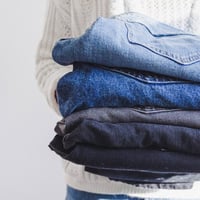The Problem Startup environments don’t tend to be the best for running your own servers. Doing so...
Sustainability and Shipping
Sustainability, the word on everyone’s lips, and the focus of extensive research, development, and innovation in the last decade. With the threat of global warming, water pollution, and resource scarcity looming, it’s clear something needs to change. And one of the industries in greatest need of a sustainable overhaul? Fashion.
Responsible for between 4-10% of greenhouse gas emissions – depending on who you ask – the global fashion industry emits over 2 billion tonnes of GHGs, uses 1.5 trillion litres of water, and will have added 22 million tonnes of microplastics to our oceans by 2050 (Ellen MacArthur Foundation, 2017), not to mention the ethical concerns around worker livelihoods in the countries producing our goods.
Okay, so it all sounds a bit doom and gloom, but the last few years have seen major leaps in both consumer sentiment and big fashion’s commitment to sustainability goals. Companies big and small have been innovating to find socially, economically, and environmentally sustainable ways of producing practical, beautiful, and well-made goods. And yet, the global fashion industry is still headed for a 60% increase in emissions by 2030 (McKinsey, 2020).
So, what can we do to help? One of the biggest contributions that brands and consumers can make is to reduce the production of emissions involved in packaging and shipping, using sustainable forms of transport, improving packaging with recycled and lighter materials, and minimising customer returns. In fact, McKinsey’s 2020 report estimates that these changes could achieve a reduction of 308 million metric tons of CO2 by 2030 – a significant achievement!
It’s clear that shipping is a key focus for meeting sustainability goals in the fashion industry, and that there are several ways for both individuals and companies to reduce emissions. From avoiding international express shipping – which uses an aeroplane rather than a cargo ship, resulting in 50x higher emissions – opting for in-store pick-up to minimise local courier traffic, or just simply reducing your number of returns, you make a significant reduction to your fashion emissions. Likewise, companies can invest in sustainable transport infrastructure, optimise their packaging so they’re not shipping half-empty boxes around the world (NOS, 2020), and make sizing more transparent so customers have a better understanding of what they’re purchasing, and are less likely to issue a return.
The issue of minimising returns is one that captured my attention and has become a core element of my work at Faslet. Faslet is a fashion tech company that uses its bespoke Size Me Up tool to accurately ascertain a customer’s size for any given garment, thus reducing the need to buy (and ship) multiple sizes, only to return the extras a few days later. Combatting the trend for high-volume returns is challenging, especially since it’s become the norm in the last decade, with over half of what consumers purchase being returned to the retailer (BBC, 2020). We believe that empowering the consumer in their decision making is the first step to cutting over-purchasing, and the excess emissions that come with it. Although we can’t address every issue that faces the world of fashion, we hope that this contribution makes steps towards thinking about, and acting upon, some of the most damaging practices in our industry.
I would love to hear your suggestions and thoughts about the state of sustainability in fashion, and how we can innovate to create a greener, fairer future.
Interested in Faslet and our work with Size Me Up? Get in touch with us below to learn more.
Sources:
BBC (2020). Can fashion ever be sustainable? https://www.bbc.com/future/article/20200310-sustainable-fashion-how-to-buy-clothes-good-for-the-climate
Ellen MacArthur Foundation (2017). A new textiles economy: Redesigning fashion’s future. Available at: https://www.ellenmacarthurfoundation.org/assets/downloads/publications/A-New-Textiles-Economy_Full-Report_Updated_1-12-17.pdf
McKinsey (2020). Fashion on climate. https://www.mckinsey.com/industries/retail/our-insights/fashion-on-climate
NOS (2020). Why we ship half-empty boxes on black Friday. (Originally published in Dutch). https://nos.nl/op3/artikel/2358082-waarom-we-halflege-dozen-versturen-op-black-friday
World Bank (2019). How much do our wardrobes cost the environment? https://www.worldbank.org/en/news/feature/2019/09/23/costo-moda-medio-ambiente




